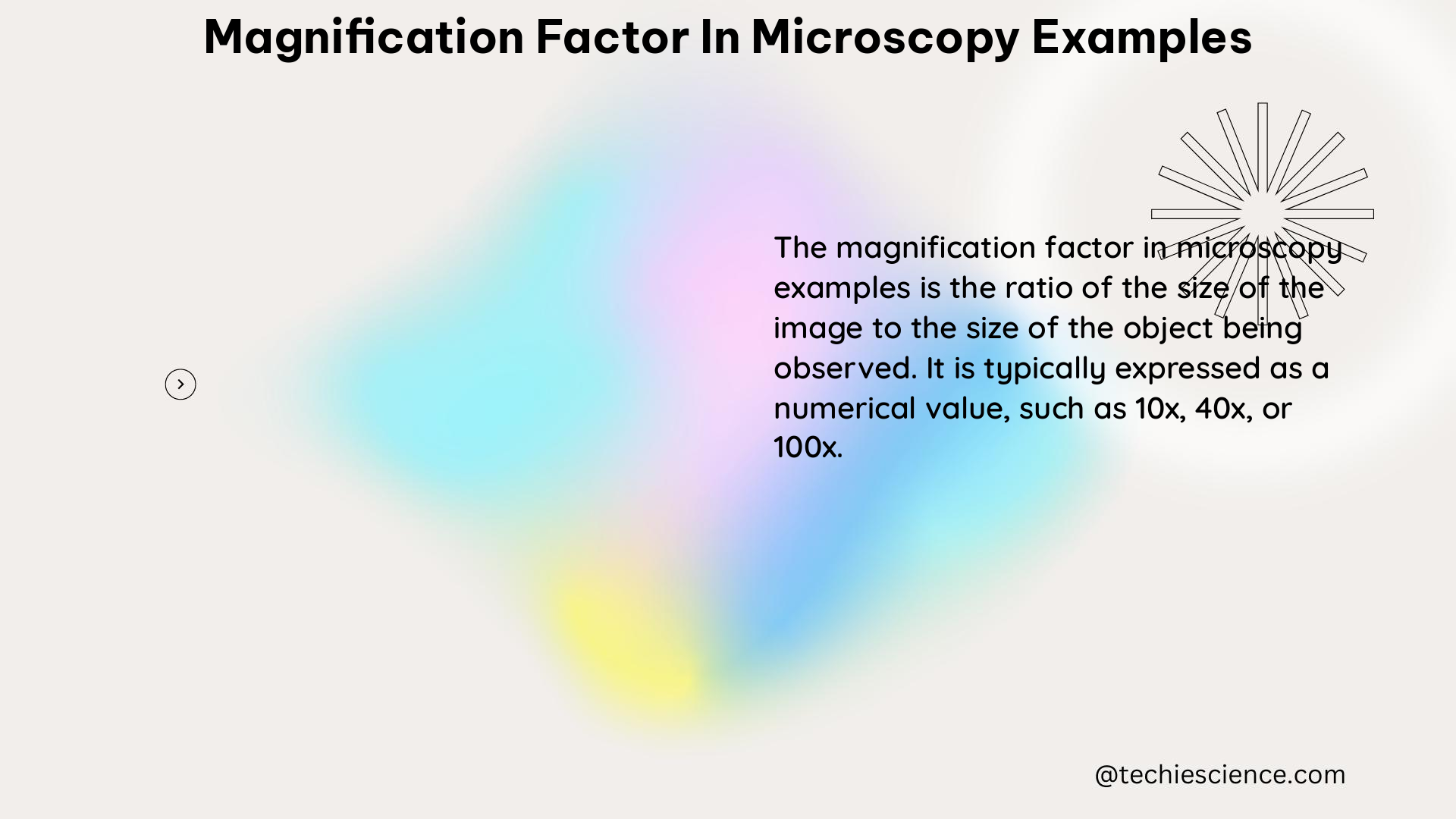The magnification factor in microscopy is a crucial aspect that determines the level of detail visible in a specimen. It is calculated by multiplying the magnification of the objective lens by the magnification of the ocular lens or eyepiece. Understanding the intricacies of magnification factor is essential for physics students working with various microscopy techniques.
Understanding Magnification Factor
The magnification factor in microscopy is the ratio of the size of the image to the size of the object being observed. It is calculated by multiplying the magnification of the objective lens by the magnification of the ocular lens or eyepiece.
The formula for calculating the magnification factor is:
Magnification Factor = Objective Lens Magnification × Ocular Lens Magnification
For example, if the objective lens has a magnification of 40x and the ocular lens has a magnification of 10x, the overall magnification factor would be:
Magnification Factor = 40x × 10x = 400x
Measuring Magnification Factor

The magnification factor can be measured by using a stage micrometer, which is a slide with a precise scale etched on its surface. By aligning the stage micrometer with the ocular micrometer and observing the number of ocular divisions spanned by the stage micrometer at a specific magnification, one can calculate the conversion factor for that magnification.
Here’s an example:
- If a stage micrometer with divisions of 0.1 mm is observed to cover the same distance as 10 ocular divisions at 100x magnification, then one ocular division equals 10 µm at 100x.
- The conversion to other magnifications can be accomplished by factoring in the difference in magnification. Therefore, the calibration would be:
- 25 µm at 40x
- 2.5 µm at 400x
- 1 µm at 1000x
Magnification in Transmission Electron Microscopy (TEM)
In Transmission Electron Microscopy (TEM), the objective lens is the most important lens, forming the images and diffraction patterns that are magnified onto the viewing screen or camera. The focal length of the objective lens must be minimized to maximize magnification, thus requiring the object distance or distance between the specimen and the objective lens to be very small.
The magnification in TEM is typically much higher than in light microscopy, with magnifications ranging from 1,000x to 1,000,000x. This allows for the observation of extremely small and detailed structures, such as individual atoms and molecules.
Calculating Microscope Magnification
The process of calculating the total magnification of a microscope can be broken down into four steps:
- Calculating the Magnification of the Microscope: Determine the magnification of the objective lens and the ocular lens, then multiply them to get the total magnification.
- Calculating the Pixel Density of the Microscope Camera Sensor: Determine the size of the camera sensor and the number of pixels to calculate the pixel density.
- Calculating the Display Size on the Monitor: Determine the size of the monitor and the display resolution to calculate the display size.
- Calculating the Final Magnification on the Monitor: Combine the magnification of the microscope and the display size on the monitor to calculate the final magnification.
By following these steps, you can accurately determine the total magnification of the optical system, providing a clear and detailed image of the specimen.
Magnification Factor Calculations and Examples
Here are some examples of magnification factor calculations in microscopy:
Example 1: Light Microscope Magnification
Objective Lens Magnification: 40x
Ocular Lens Magnification: 10x
Magnification Factor = Objective Lens Magnification × Ocular Lens Magnification
Magnification Factor = 40x × 10x = 400x
Example 2: Transmission Electron Microscope (TEM) Magnification
Objective Lens Magnification: 50,000x
Ocular Lens Magnification: 10x
Magnification Factor = Objective Lens Magnification × Ocular Lens Magnification
Magnification Factor = 50,000x × 10x = 500,000x
Example 3: Calculating Magnification with a Stage Micrometer
Stage Micrometer Division: 0.1 mm
Ocular Divisions Covered by Stage Micrometer: 10 divisions
Objective Lens Magnification: 100x
Magnification Factor = (Stage Micrometer Division / Ocular Division) × Objective Lens Magnification
Magnification Factor = (0.1 mm / 10 divisions) × 100x = 1000x
In this example, the stage micrometer with divisions of 0.1 mm covers 10 ocular divisions at 100x magnification, which means that one ocular division equals 10 µm at 100x magnification.
Conclusion
Mastering the concept of magnification factor is crucial for physics students working with various microscopy techniques. By understanding the formulas, measurement methods, and practical examples, students can accurately determine the total magnification of the optical system, leading to a clear and detailed observation of the specimen.
References
- Measurement with the Light Microscope – Rice University
- Transmission Electron Microscopy | Nanoscience Instruments
- Microscope magnification calculation – a bit more advanced – YouTube

The lambdageeks.com Core SME Team is a group of experienced subject matter experts from diverse scientific and technical fields including Physics, Chemistry, Technology,Electronics & Electrical Engineering, Automotive, Mechanical Engineering. Our team collaborates to create high-quality, well-researched articles on a wide range of science and technology topics for the lambdageeks.com website.
All Our Senior SME are having more than 7 Years of experience in the respective fields . They are either Working Industry Professionals or assocaited With different Universities. Refer Our Authors Page to get to know About our Core SMEs.